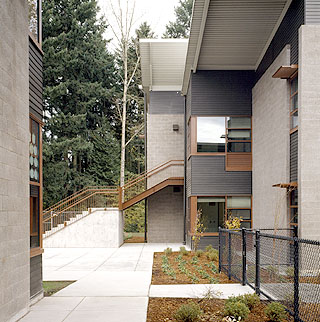|
Subscribe / Renew |
|
|
Contact Us |
|
| ► Subscribe to our Free Weekly Newsletter | |
| home | Welcome, sign in or click here to subscribe. | login |
Construction
| |
 |
August 31, 2006
Does your school building make the grade?
Mahlum Architects

Reifert
|
How well does a school building work after it’s designed and built? Although hundreds of new buildings are occupied every year, only a fraction have post-occupancy evaluations conducted.
Post-occupancy evaluations of educational structures have a nearly 40-year history, but until recently surprisingly few school districts nationwide sought to evaluate whether their new K-12 buildings met the needs of students and teachers. This may be the result of fears that such evaluations might be costly, that results might reflect negatively on districts or their design teams, or that there appeared to be no clear economic incentives to do so.
Yet post-occupancy evaluations offer educators and school districts a way to evaluate how a facility is functioning, how students and teachers are using the space and how the educational process has changed.

Photo by Benjamin Benschneider Lake Washington School District relied on evaluations of several of its schools to help plan its new Benjamin Franklin Elementary School in Kirkland. The district considered issues such as acoustics, maintenance, heating and ventilation and shared activity areas. |
They can be a tool for districts planning new schools or capital expansion programs. Post-occupancy evaluations are particularly effective in evaluating green or sustainable factors such as savings in energy and water usage, and financial costs. They also provide useful information on the effectiveness of new products, technologies and techniques.
Standards vary
There is, however, no standardized post-occupancy evaluation.
The Council of Educational Facility Planners International has developed post-occupancy evaluation criteria such as the school site, structure and mechanical features, maintenance, building safety and security, educational adequacy and learning environment. The National Clearinghouse for Educational Facilities offers a rating system for evaluating classroom environments and arrangements, indoor and outdoor learning space, dining areas and informal social spaces.
It is usually left to school districts to develop their own evaluation models, and these vary from state to state and from district to district.
Locally, the Lake Washington School District is committed to post-occupancy evaluations to understand the effects of buildings — particularly ones with high-performance design — on staff retention, student absenteeism, energy savings and the true cost of ownership.
The evaluations measure customer satisfaction, provide excellent planning tools and help ensure that new buildings are educationally functional.
The district relied on evaluations of several schools to help in the planning of its new Benjamin Franklin Elementary School in Kirkland.
Survey participants commented on such issues as daylighting, acoustics, maintenance, classroom sizes, administration offices, community use, heating and ventilation, teacher planning areas, shared activity areas, and overall building configurations.
New school evaluated
Mahlum Architects made use of this information in designing Franklin, which opened in the fall of 2005 and has been named one of the nation’s top 10 green building projects by the American Institute of Architects.
Environmentally sustainable design principles incorporated in the building include fresh air, daylighting, waterless urinals, operable windows, nontoxic carpet tiles and paint, a stormwater management system that cleans and reduces runoff, and small learning environments grouped around central instructional areas.
Now that Franklin has been open for a school year, the district has done an evaluation of the building’s performance.
Working with the New Buildings Institute, a nonprofit foundation, the district found that students and teachers responded well to daylighting and students were more attentive. Their afternoon slumps lessened because carbon dioxide sensors activated the intake of fresh air through windows and ventilation louvers.
Rubber flooring in the gymnasium, commons and shared activity areas reduced noise. The rubber, as well as the retroplated concrete floors, required only minimal mopping, freeing custodial staff to focus on other maintenance chores.
The school received high marks for comfort, which should enhance the learning environment.
Getting useful feedback
But a few challenges also emerged, notably an acoustical problem that the district may address by installing white-noise canisters.
Because the mechanical units don’t have fans, the building is so quiet one can hear noise from adjacent classrooms. Some classrooms may also need better solar control to reduce overheating.
This kind of feedback will help the district make adjustments to the current building and plan new ones.
Although post-occupancy evaluations are normally limited to new schools and done only once, Forrest Miller, director of support services at Lake Washington, believes districts should undertake more comprehensive building performance reviews every year, and that they should include reactions from service providers.
“My goal is that we will expand (post-occupancy evaluations) beyond a tool that is only used after a project is completed to a tool that is utilized on an annual basis at all schools so that we can measure building performance, customer satisfaction and provide information to allow us to do informed planning,” Miller says.
Such ongoing reviews would be especially valuable in determining whether a school meets high performance or sustainable standards.
The state Legislature has mandated that beginning in July 2007 all Class A school districts will be required to adhere to high-performance, sustainable design standards for any new school building. (And all districts will be required to meet the standards in 2008.) Yet there are no uniform statewide guidelines that districts can use to monitor their performance.
It could well be that the Lake Washington School District’s approach to an expanded post-occupancy evaluation, or building performance review, could become the model for districts across the state.
Gerald “Butch” Reifert is a principal with Mahlum Architects, with offices in Seattle and Portland.
Other Stories:
- Getting around permitting hurdles takes creativity, teamwork
- Schools losing out as construction costs soar
- Flexible classrooms are a perfect fit
- Careful builders can avoid contract disputes
- Gateway opens up a closed-off campus
- State beefing up health and safety requirements
- Rain gardens: effective, natural and cheap
- Partnerships a high note for school, community


